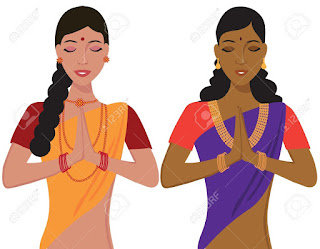INDIAN CULTURES
 |
| ' NAMASTE' |
| The life of Indians is centered in the
family. Extended families often live together, with two or more adult
generations, or brothers, sharing a house. Hinduism is the predominant religion ofIndian
people and over 80% of Indians identify themselves as Hindu (Office of the
Indian Registrar, 2001). |
Discipline
One common
trait you will find amongst Indians is that children show utmost respect to
their elders. Now this is one habit all Indian parents deliberately inculcate
in their children, since beginning. It is an unsaid rule in India that a person
cannot answer back to elders and more so, when he/she is at fault. It is deemed
disrespectful in India to refer to an elder by his / her name. Instead people
prefer calling them uncle and aunt, especially if the person is very elderly.
It is also customary in India for the youngsters to touch the feet of their
elders as a way of greeting as well as on important occasions.
Life
Individuals
are also ranked according to their wealth and power. For example, some powerful
people, or “big men,” sit confidently on chairs, while “little men” come before
them to make requests, either standing or squatting not presuming to sit beside
a man of high status as an equal.
Marriage
Marriage is deemed essential for virtually
everyone in India, marking the great watershed in life for the individual. For
most of Hindu northern and central India, marriages are arranged within the
caste between unrelated young people who may never have met. Among some south
Indians communities, families seek to strengthen existing kin ties through
marriages with cousins whenever possible. For every parent, finding the perfect
partner for one’s child is a challenging task. People use their existing social
networks, and increasingly, matrimonial newspaper advertisements. The
advertisements usually announce religion, caste, educational qualifications,
physical features, and earning capacity, and may hint at dowry size (even
though giving or accepting dowries is actually illegal).
Conservative
means holding to traditional attitudes and value, cautious about change or innovation,
typically in relation to politics or religion. Conservative term applies in Hinduism
where Hindu women of conservative families veil their faces and remain silent
in the presence of older male in-laws, both at home and in the community. A
young daughter-in-law even veils from her mother-in-law. These practices
emphasize respect relationships, limit unapproved encounters, and enhance
family lines of authority.
Socialization
Societal
hierarchy is evident in caste groups, amongst individuals, and in family and
kinship groups. Castes are primarily associated with Hinduism, but caste-like
groups also exist among Muslims, Indian, Christians, and other religious
communities. Within most villages or towns, everyone knows the relative
rankings of each locally represented caste, and behavior is constantly shaped
by this knowledge.
Socialization
of children in Indian families in the traditional setting tended to focus on
sociocultural continuity rather than change. However, this emphasis on
continuity is gradually giving way to respect for initiative, which was not a
feature of traditional upbringing. The present study is attempting to draw
attention to transitional aspects of child rearing, which is showing signs of
significant changes in parent-child interactions. There is two point of view
one can consider as basis of socialization, traditional and modern.
 |
| Modern Indian |
 |
| Traditional Indian |
According
to traditional view of socialization in Indian context, a good child, in
traditional context may be described as humble, intelligent, although not
necessarily brilliant, kind to small babies and animals, religious, in sense of
going to temple once a day, noninterfering, and well-behaved in not being
mischievous and avoiding quarrels with other children. He should, above all, be obedient and respectful to
elders.
The
whole family is involved in rearing of children. Socialization of children is
not the exclusive responsibility of their parents in the Indian home. Where the
grandparents are alive, the parents occupy a secondary role in disciplining and
bringing up the children. The grandmother or aunt often becomes an important
influence in the lives of young people.In the Indian household, lines of hierarchy and authority are
clearly drawn, and ideals of conduct help maintain family harmony. All family members
are socialized to accept the authority of those above them in the hierarchy.
The eldest male acts as family head, and his wife supervises her
daughters-in-law, among whom the youngest has the least authority.
Reciprocally, those in authority accept responsibility for meeting the needs of
other family members.
Academic
Many
Indians are part of the Malaysian working class also exists a large group of educated upper middle class
professionals. Indians are well represented in Malaysian medical and legal
fraternities. Indians also form a large portion of English language teachers in
Malaysia. Law and medicine have traditionally been the preferred career choices
in Indian families although more young Indian Malaysians are now venturing into
other fields such as engineering, finance and entrepreneurship. Ananda Krishnan
and Tony Fernandes are examples of notable Malaysian tycoons of
Indian heritage. Some being sent to Tamil primary schools and use Tamil as the medium of
instruction while Malay and English are being taught in Kebangsaan school,
Indian childrens are succeeding well in studies.
REFERENCE
Indian Society and Ways of living,
2015.M.Gail Hickey
http://www.researchgate.net/publication/48512201_Asian_Indian_Family_Socialization_Patterns_and_Implications_for_American_Schooling
Kurian,G,Ghosh,R:Changing Authority Within the Context of Socialization in Indian Families,Vol.53,No.1
http://www.jstor.org/stable/41886219?seq=1#page_scan_tab_contents












